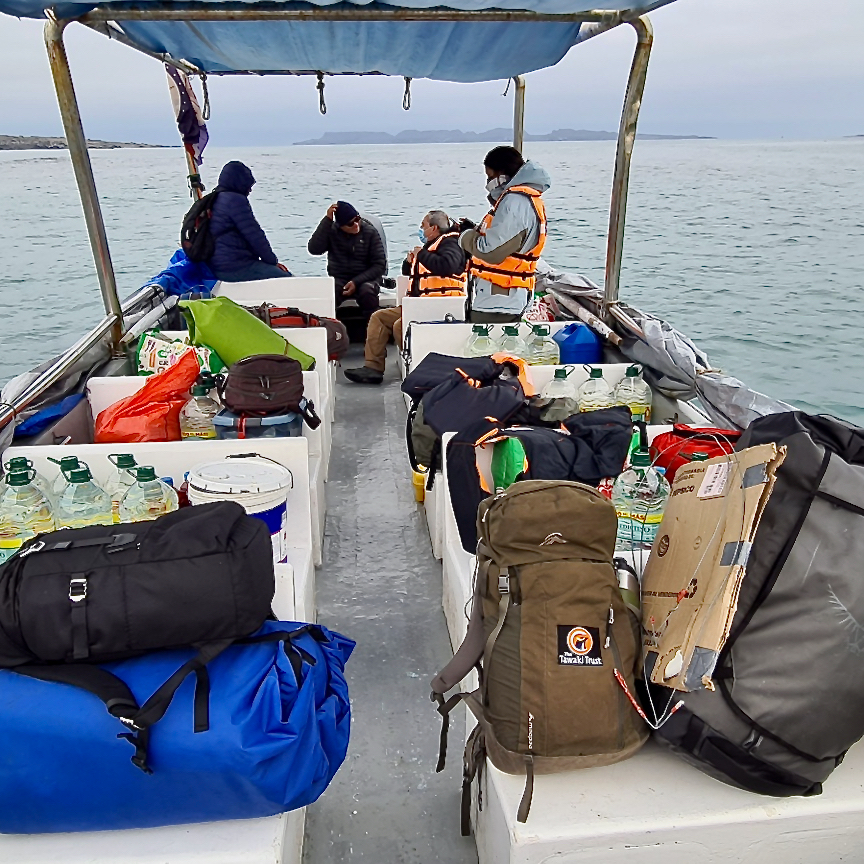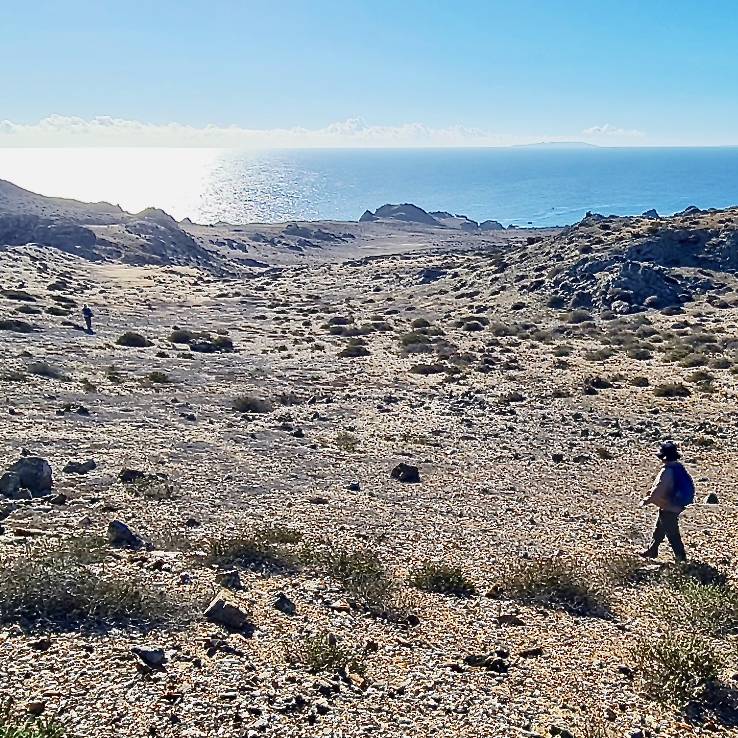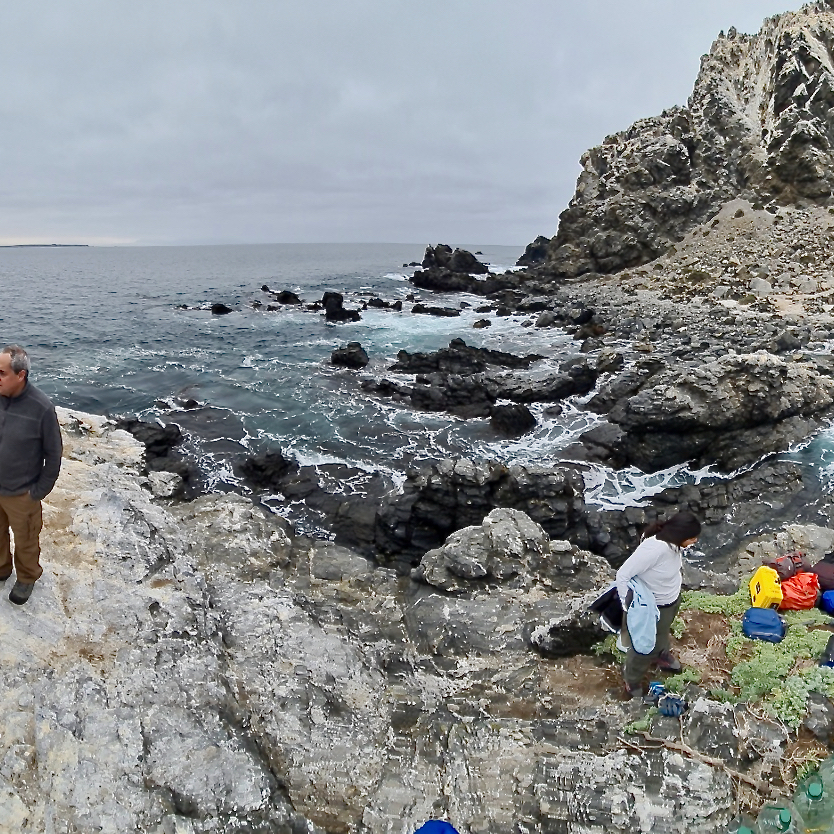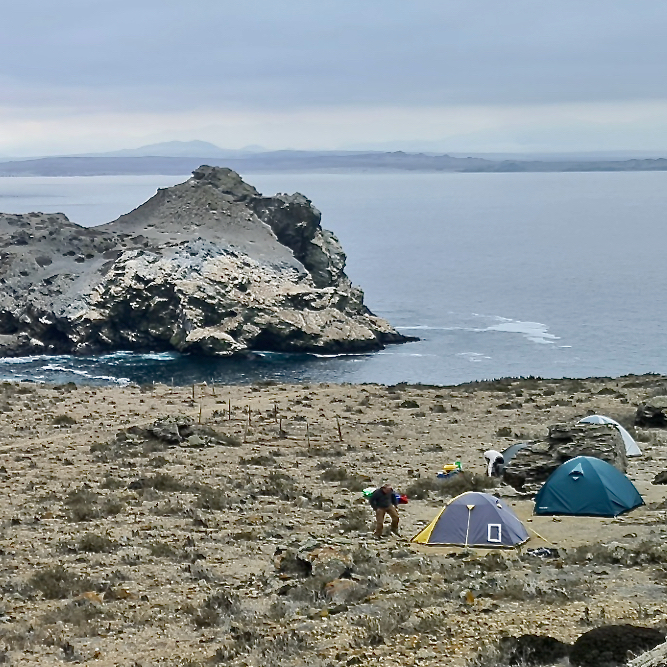Choros Island, Coquimbo Region, Chile, June 13, 2022
June 13 - Day 1
We have indeed made it and arrived on Isla Choros. And we have cutting-edge mobile phone reception here – unbelievable for me! So I won't miss the opportunity to send you a short expedition report. (sorry in advance for any spelling or grammar mistakes - I'm typing all this on my cell phone while lying in my tent).
After spending a night in Punta Choros, our team – there are four of us: Alejandro, Max, Karen and Thomas - finally left for Isla Choros this morning at approximantely 10am. There was almost a week's delay, as Alejandro had fallen ill with Covid-19 beforehand.
After the passage to Isla Choros, which took about half an hour, the adventure of landing there began. The island can only be accessed via an offshore rock, which, however, is cut off from the beach at high tide. Once we had dragged our uncountable bags, expedition boxes and suitcases on the rock with much effort, we still had to wait there for about 1 hour, before we could finally take our equipment ashore.
But unfortunately, we were far from having arrived there. Because of several precautionary measures due to the ever-threatening danger of tsunamis, you are not allowed to camp on the beach of Isla Choros any more. Instead, we first had to bring our fuss to the plateau located about 80 meters above us. Just a narrow trail through colonies of petrels leads up there.
About 3 hours after our team had jumped off the boat onto the rock, we slumped in exhaustion in our camp between equipment that felt like tons we had hauled up here to the plateau.
After a well-deserved break, a first inventory was on the agenda in the afternoon. How many Humboldt penguin nests are active and which breeding phase are they currently in. For the project, we would like to focus on nests with chicks.
Humboldt penguins, which have been hunted by humans for thousands of years, are naturally extremely shy. Therefore, it is important to work with penguins that have a close bond with their nest, which is not the case before the chicks hatch. Before that, the risk is too great that the penguins, which could be disturbed through our interactions, would abandon their nest.
The first nests were a bit worrying – at first we only found penguins on eggs. Are we too early?
By the end of the day, though, we were successful in recording positions of about 15 nests with chicks. However, most of these chicks are only a few days old, so we will still have to wait quite some time before we can equip their parents with GPS data loggers.
Towards sunset, the island came alive. Hundreds of petrels returned to their nests and have been filling the silence over the island with their guttural song since then. In between, the trumpeting of the Humboldt penguins can repeatedly be heard.
Listening to this concert, in our tents the first day on Isla Choros is drawing to a close.
June 16 – day 4
The first four days on Isla Choros would probably have caused a perimeter to explode. Fortunately, nobody on the team wears a fitbit or something similar on their arms. Although the island is only 4 km long, the four of us were busy walking an estimated 200 km, always on the lookout for penguin nests, which are suitable for our work.
I alone recorded the positions and features of 90 penguin nests, focusing mainly on half-closed nests. Because this is a fundamental requirement for our work: a nest with only one entrance, as spacious as possible but not too deep.
Humboldt penguins do not like being picked up by humans. On top - if these humans additionally attach small GPS tachographs to their feathers, it makes the birds even less happy. This can make them think of just running away, which in turn would not end well for the chicks. If, however, a penguin that has just undergone the ten-minute equipment procedure is released into a closed nest, not only escape can be prevented, but in addition direct contact with the offspring is established, which chases away the last thoughts of escape.
Therefore, closed nests with chicks, which are at least one week old, is what we need. Unfortunately, we seem to have arrived on the island about two weeks too early, because most of the nests on Isla Choros contain eggs or just-hatched chicks.
But they do exist, the nests that we need. We just had to search for four days. And tonight, at about 6 p.m., we applied the tenth and last of our GPS trip recorders on a penguin!
Now it is important to wait. The plan is to leave the devices on the birds for 5-8 days. In an ideal situation, we might track them on two or more hunting trips. But it seems to us that the penguins go on trips of 2-3 days in length. Therefore, we have lowered our expectations a bit.
Next week we will know more!
June 19 – day 7
We have the first data!
After we equipped the last 3 birds with GPS loggers 5 days ago now, today was the time to collect the devices. Unfortunately, not everything went as well as we had hoped.
The first nest has been abandoned after the chicks were eaten by a vulture in the course of the day. We applied the devices during the night. So the disappearance of the chicks cannot be attributed to our intervention. We have not seen anything of the bird with the device since and we have to give up on this one.
In the second nest, we removed the GPS logger from the bird yesterday. The reason for this is
that this penguin has not left the nest for days. His partner is lost at sea and it doesn't look good for the hungry chick. The partner was not on the nest when we attached the device. Therefore we assume that our intervention had no influence here.
In the third nest, we have just found our logger bird and recovered our device. This female has made two hunting trips in the past four days. And the data is excellent!
June 20 – day 8
We have recovered four more tachographs from penguins today. For a pilot study, we already have great data!
Thomas Mattern
translated by Angelika Veelken






